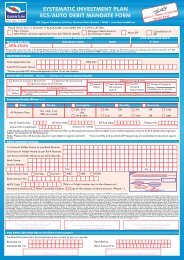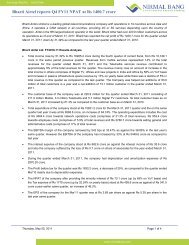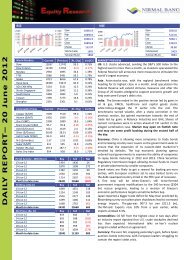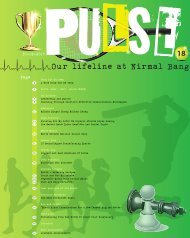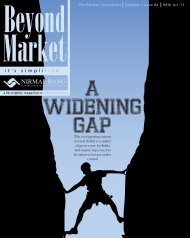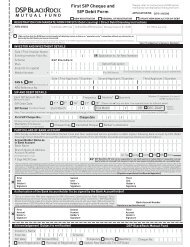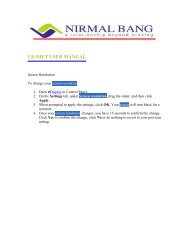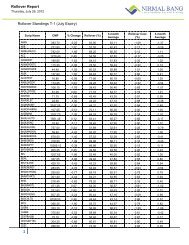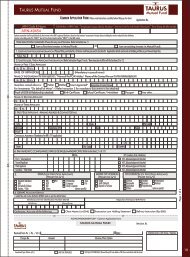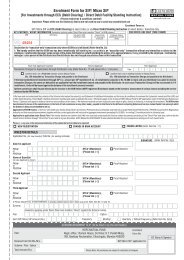Institutional Equities - Online Share Trading
Institutional Equities - Online Share Trading
Institutional Equities - Online Share Trading
You also want an ePaper? Increase the reach of your titles
YUMPU automatically turns print PDFs into web optimized ePapers that Google loves.
<strong>Institutional</strong> <strong>Equities</strong><br />
Exhibit 16: ABC expressway<br />
RoE trend of BOT projects<br />
Infrastructure projects are capital intensive, highly leveraged, have a long gestation period and a low operating<br />
cost. Therefore, in the initial phase, post commercial operation capacity charges (depreciation and interest<br />
costs) are higher, which suppresses margins and thereby the return ratios. However, infrastructure projects<br />
generally have a predictable cash flow, long-term inflation-linked income stream and a low loan default rate<br />
and therefore we look at the returns generated by the project in terms of equity IRR and value in terms of<br />
DCF.<br />
Case study<br />
We have analysed here a BOT road project costing Rs12.9bn having a concession period of 15 years. We<br />
have assumed traffic growth of 5% and interest rate of 11% per annum. Based on our analysis, we have seen<br />
that in the initial five years the company’s returns ratio was low, but the next five years’ returns ratio was high.<br />
Hence, earnings-based valuation will not give the right valuation for its assets. We think the DCF model is the<br />
best way to value BOT assets, as it takes into account long-term free cash flows after factoring in capex<br />
phasing, debt repayment and working capital requirement. BOT projects have a predicable future cash flow<br />
and a definite concession period, giving a fixed valuation horizon and also there is no need to assume longterm<br />
growth rate.<br />
ABC Expressway<br />
Length of the highway (km) 206<br />
Total project cost (Rsmn) 12,920<br />
Equity (Rsmn) 3,230<br />
Debt (Rsmn) 9,690<br />
Total 12,920<br />
Concession period (Year) 15<br />
Traffic growth rate (%) 5%<br />
Interest rate on term loans (%) 11%<br />
Discounting rate for FCFE (%) 15%<br />
Exhibit 17: Project RoE, RoCE trend<br />
(%)<br />
30<br />
25<br />
20<br />
15<br />
10<br />
5<br />
0<br />
(Yr)<br />
Low return ratio<br />
High return ratio11<br />
1 2 3 4 5 6 7 8 9 10 11 12 13 14 15<br />
RoE (%) RoCE (%)<br />
Source: Nirmal Bang <strong>Institutional</strong> <strong>Equities</strong> Research<br />
Exhibit 18: Infrastructure companies’ RoCE trend<br />
Source: Nirmal Bang <strong>Institutional</strong> <strong>Equities</strong> Research<br />
Exhibit 19: Infrastructure companies’ RoE trend<br />
(%)<br />
16<br />
(%)<br />
25<br />
14<br />
12<br />
10<br />
8<br />
6<br />
4<br />
2<br />
0<br />
FY08 FY09 FY10 FY11 FY12E FY13E<br />
IRB Infra Reliance Infra GMR Infra HCC IVRCL<br />
20<br />
15<br />
10<br />
5<br />
0<br />
(5)<br />
(10)<br />
(15)<br />
FY08 FY09 FY10 FY11 FY12E FY13E<br />
Loss reported due to higher<br />
capacity charges<br />
IRB Infra Reliance Infra GMR Infra HCC IVRCL<br />
Source: Company, Nirmal Bang <strong>Institutional</strong> <strong>Equities</strong> Research<br />
Source: Company, Nirmal Bang <strong>Institutional</strong> <strong>Equities</strong> Research<br />
9 Infrastructure Sector



